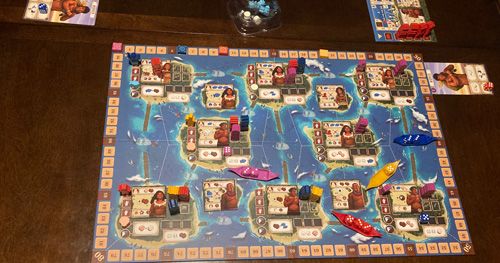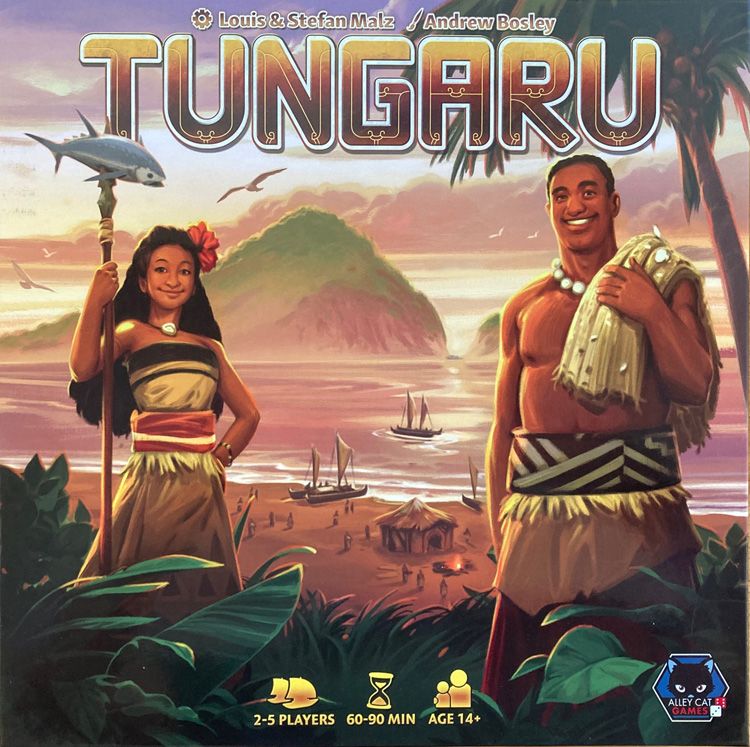Tungaru is a dice placement game published by Alley Cat Games. The premise of this game is to gather goods, settle on lands and recruit nomads into your tribe. Once a nomad is recruited from a location where there is no possible replacement, the game end is triggered. All game end victory points are calculated and the player with the most points wins.
This post is broken into the following 3 sections, feel free to jump directly to one:
- General summary - consisting of information about overall enjoyment, theme, replayability, and upgrades
- Complexity - consisting of information about the rulebook, setup, player turns, and overall learning curve
- Player turns - consisting of game type, game flow, rule you are likely to miss, and favorite aspect
General Summary
Number of players we had: 4
Our play time (not including setup): 2.25 hours
Overall enjoyment

Overall our group enjoyed playing this game for several reasons. First, the scoring is Euro styled, meaning it is impossible to tell who is going to win even if you think you know. It may appear that one player is doing far better than anyone else, but this does not necessarily mean they will win in the end.
Second, there are lots of ways to strategize in this game. Players can focus on establishing settlers to acquire additional actions without the use of dice, using leader cards and abilities, or on recruiting nomads who produce goods or provide a way to score points, as well as those who provide points at the end of the game.
Lastly, while this game might feel slightly overwhelming as you are setting it up, player actions are fairly easy to learn. Players use dice to trigger actions and choose one of five leader cards each round. Each leader card has a unique ability and benefit. Additional actions can also be acquired from certain nomads. All of the actions provided by player dice, settlers, recruited nomads and leader cards can be used in any order. This means players often have varying numbers of actions in a single round.
If we had to pick something that frustrated us it would be that sometimes when you plan something to accomplish in a round, another player(s) may block you whether intentionally or not. Each island location only has space for three dice to trigger actions. These actions can be used for harvesting, placing a settler, trading, traveling, or recruiting a nomad.
This means with a four or five player game, it can be VERY easy to fill up an island's dice placement spaces. Though players can only trigger actions on islands when their boat is anchored next to it, as the game goes on players become better at utilizing leaders and recruited nomads to get more done each round. The result of this is that players may start out alone next to an island, with a plan in mind, only to find themselves with other players who have thwarted their plans. Still, this is how the game is played and it does force players to be more strategic.
Theme

When I backed this game on Kickstarter, I ordered the deluxe version, so please keep that in mind as I discuss the components. The colors of all the tokens are nice, bright colors. The one thing I will say is it can be slightly challenging to see some of the silkscreen colors. For instance, the light color on the yellow monuments does not stand out as well as it could, which is really a shame because the designs are fantastic!
Still, we love the designs and the fact that each color has its own unique design as well, which obviously took more work and care to create. Additionally , the culture boards are easy to use, have a lot of information, and yet do not take up a bunch of real estate in front of you. Aside from the pearls which are slightly plain, the wooden tokens are quite unique. All the components fit well on the culture boards as well as the main board.
Replayability

This game has a high replayability. We love that the board is double-sided and based on the number of players. This ensures the game is always challenging. There are a great deal of nomads to recruit that can come out in any location and in any order. There are also 16 island tiles that can change what is available to harvest and trade at the islands. The people you play with also affect the game and how it plays. Lastly, the dice element makes each game vastly different because their numbers are capable of activating different actions at islands, on acquired nomads and on leader cards.
Upgrades

As mentioned above, I purchased the deluxe version of the game which meant it came with plastic boats to hold the dice, silkscreened 4D monuments, 16 island overlay tiles, and 4 extra nomads. When I backed the game, the deluxe edition was an additional $16, at a total cost of $53. Considering all the components in this game and the quality, I would expect to pay more and feel this is a great value!
Complexity
Rule book
The rule book uses oversized glossy paper that is very well organized, has lots of images with explanations and examples to help you learn this game faster. While there are more rules than some of the games we have played, the game overall is not that complex, rather it is a matter of understanding all of the possible actions and abilities players can utilize. In this way, this game reminds me of Merchant's Cove which also feels more intimidating during setup than game play really is.
Setup
Setting up this game takes about 15 - 20 minutes. There is nothing overly complex about the setup, it is just a matter of there being several steps in getting the nomads placed, all player tokens to each player, determining the first player, and setting up the goods somewhere where all players can access them. NOTE: Be sure you select the correct board side based on the number of players you have.

Turns
Each player begins the game with the same set of five unique leader cards. At the end of a round, players pass the leader card they used to the player to their left. This means that over time, while players will always have five leaders cards in their hand, they are likely not going to have all leaders to choose from each turn. This is important because each leader has different abilities, benefits and special dice action spaces, so players need to be very strategic when picking which leader to play each round.
As an example, the fisher provides a fish during the second phase when leader abilities are resolved. The leader benefit of the fisher is that players can sail without spending a die. This means it is more strategic to play this card when players hope to move during their turn so they do not waste the available leader benefit.

Overall learning curve
The game feels more complex when you first set it up than it is once play begins and there are several reasons why it is easier to pick up than it seems. For one thing, there are several symbols that are used over and over again in the rulebook, on the culture boards and the game board to reinforce how they are used. Also, three out of the four phases of each round are performed simultaneously, so players are learning together and players can help one another as needed. Lastly, the rulebook really does a great job describing and explaining how the game is played!
Player Turns
Play type
Tungaru is a symmetrical worker placement game that utilizes dice as workers. The neat aspect of that is that the first player of each round rolls their dice and those dice numbers rolled are the dice every player uses that round! This makes each round slightly unpredictable while ensuring each player has the same opportunity to perform actions each round. In other words, someone who always rolls horrible dice, and yes they exist, is not penalized!
This game can be quite competitive even if your group does not intentionally play that way. Part of this is caused by the limited dice placement spaces on each island. Another part is due to players selecting their leader cards privately so that other players do not always know of their intentions. Sometimes it is simply a matter of multiple people going for actions on the same island, whether intended or not.
Game flow
The first two phases of each round are done simultaneously and are very quick. The third phase is where players get to take actions using dice placement which allows them to use island actions and recruit nomads, utilize leader benefits and activate settlers. Over time, rounds can get longer as players work to take advantage of all the plays they possibly can while battling other players for the same island abilities. Once someone gets blocked from doing something they want, play can slow as players look for other ways to accomplish what they set out to do - or switch to something else entirely.
Rule you are likely to forget
When a nomad is recruited, one of the nomad tiles on the migration spaces slides into the empty slot left behind. Be sure you always remember to do this right away because some migration spaces can fill multiple islands and if multiple nomads are recruited without being replaced, it can be difficult to remember which one was recruited first and where nomads on migration spaces should go.
Also, remember to pay your two fish when placing a settler. I'm not sure why we kept forgetting this - it is on the culture board - but it is something we missed a few times!
Favorite aspect
This game has a lot going on from the moment you start, but it is not overly complex. A great deal of the complexity comes from trying to accomplish things while battling other players for the same dice placement spaces. Luckily, there are several strategies players can take to earn victory points and if you place settlers you can still take advantage of some island abilities without the use of dice.
One of the things I most love about this game is the unpredictability of it all. While each player begins with the same five leaders, once you play one, you do not know when you will have access to that leader again because that is completely dependent upon what the player before you plays. The dice being rolled each round by the first player also randomizes the game - without giving any one player an advantage.
Lastly, while players can gain victory points during the game, a great deal of victory points are awarded at the end of the game. These points come from the collected nomads and because many of these are in an inactive state, players have absolutely no idea how many victory points each player will get in the end. Our group is a fan of not really knowing who is winning the entire game as it pushes us to play our best without thinking about who is winning.
In summary, this game provides a great deal of opportunity to strategize without being overly complex or confusing. Setup and cleanup are fairly quick and easy and we have enjoyed playing this game several times already. We love the detail paid to the monuments and settlers and the fact that each culture is completely unique in color and style. This is a more strategic game that can be played in less time than some which might make it a great addition for your group.


